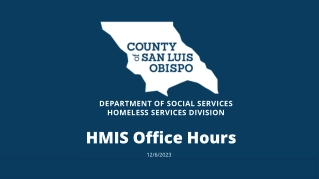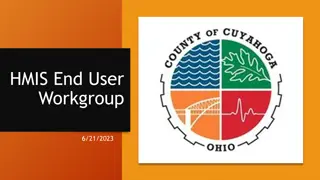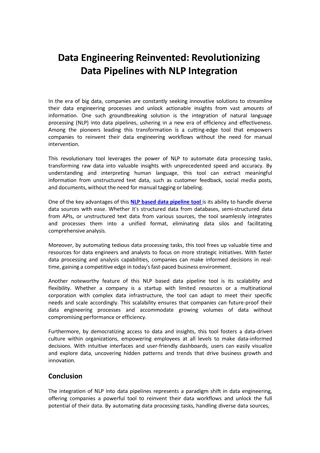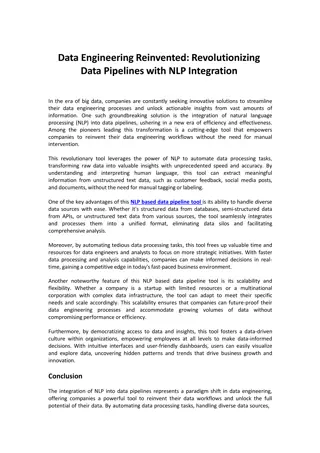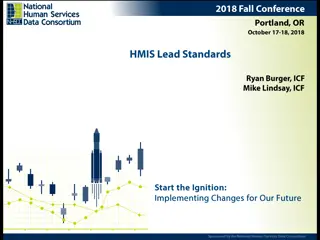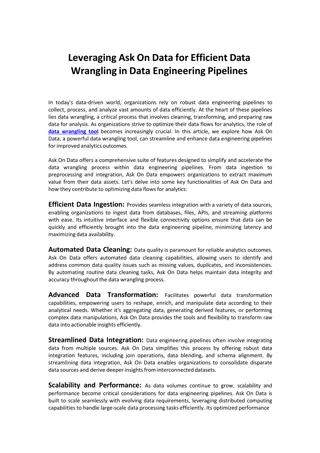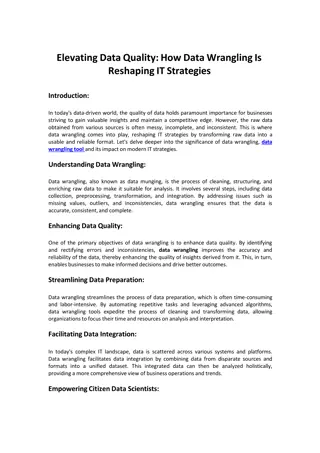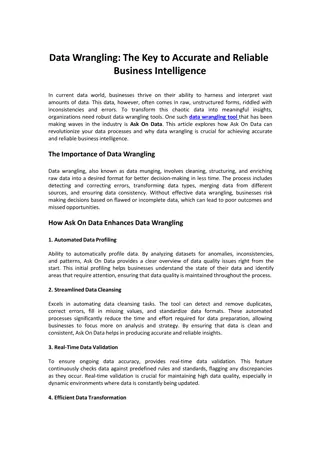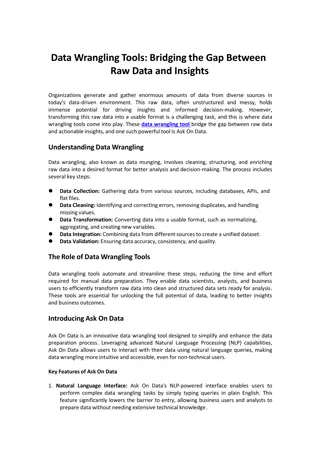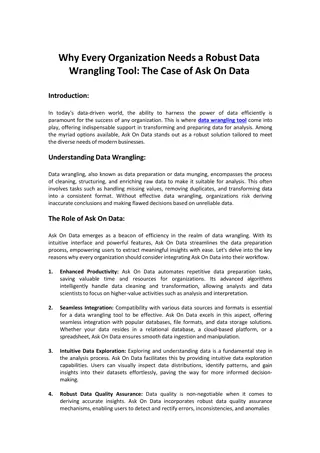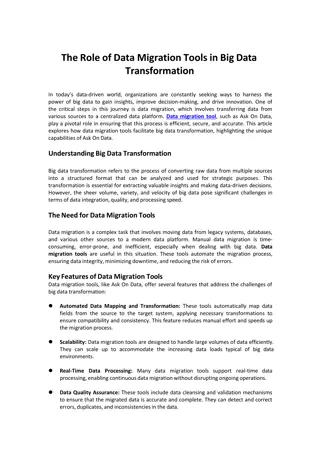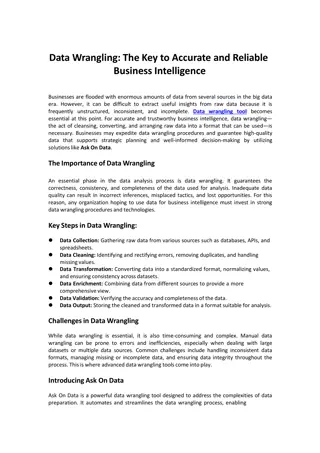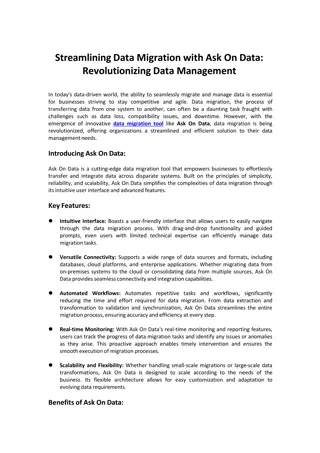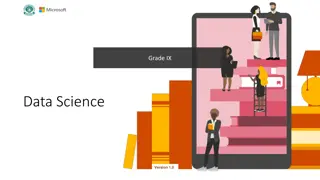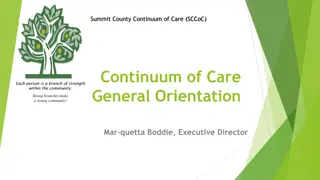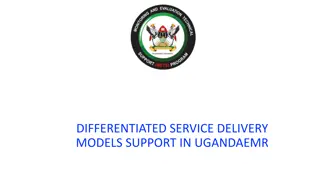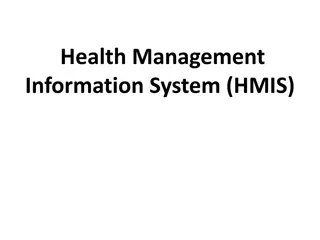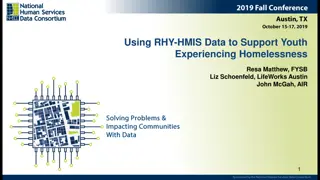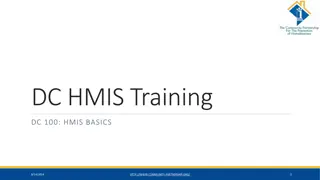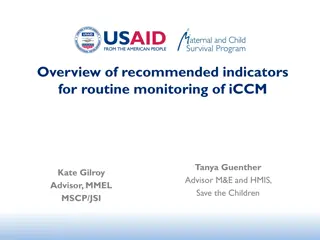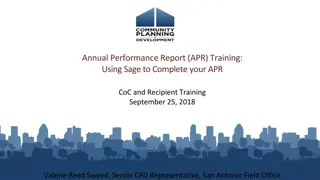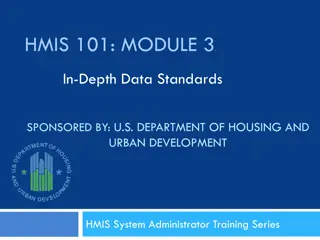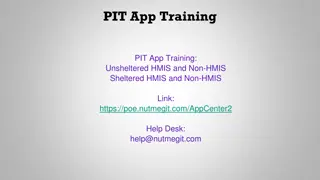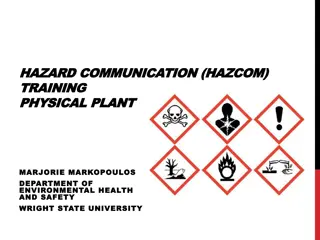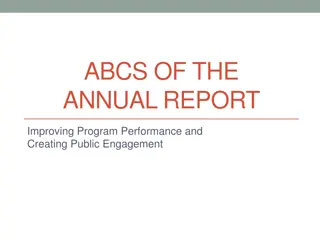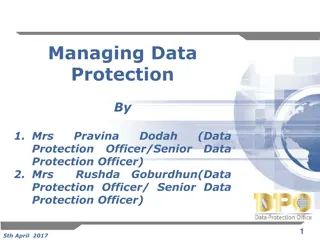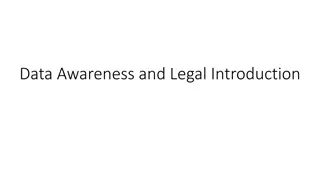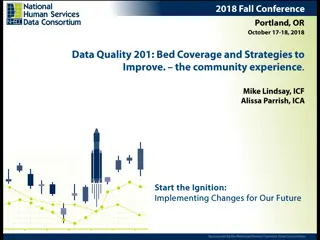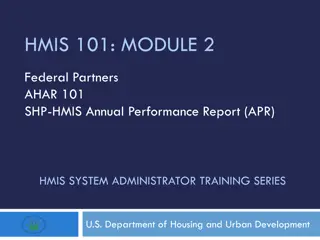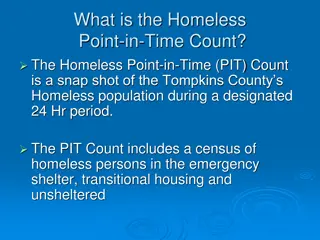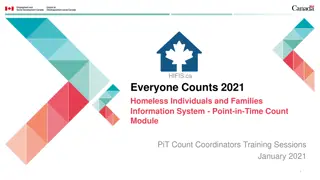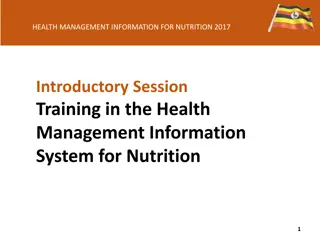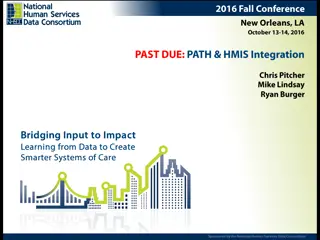DEPARTMENT OF SOCIAL SERVICES HOMELESS SERVICES DIVISION. HMIS Office Hours
Reviewing and correcting data quality issues in the Department of Social Services Homeless Services Division, focusing on inaccurate homeless history, services outside of enrollments, and their impacts on migration workflows and system performance. The team, led by project managers and system analys
2 views • 12 slides
The Digital Personal Data Protection Act 2023
The Digital Personal Data Protection Act of 2023 aims to regulate the processing of digital personal data while balancing individuals' right to data protection and lawful data processing. It covers various aspects such as obligations of data fiduciaries, rights of data principals, and the establishm
3 views • 28 slides
HMIS End User Workgroup Discussion Overview
This post provides key details about the HMIS End User Workgroup meeting held on 6/21/2023. It covers the introduction of committee members, discussions on HMIS data standards, communication strategies, and important resources for end users. The workgroup's vision, purpose, and upcoming changes in t
5 views • 27 slides
Supporting Youth Experiencing Homelessness Through RHY-HMIS Data
Utilizing RHY-HMIS data to aid youth facing homelessness is crucial. The Runaway and Homeless Youth Program emphasizes trauma-informed, age-appropriate services to help youth transition successfully to adulthood. Funding streams like Street Outreach, Basic Center, and Transitional Living provide ess
4 views • 24 slides
NCI Data Collections BARPA & BARRA2 Overview
NCI Data Collections BARPA & BARRA2 serve as critical enablers of big data science and analytics in Australia, offering a vast research collection of climate, weather, earth systems, environmental, satellite, and geophysics data. These collections include around 8PB of regional climate simulations a
6 views • 22 slides
Revolutionizing with NLP Based Data Pipeline Tool
The integration of NLP into data pipelines represents a paradigm shift in data engineering, offering companies a powerful tool to reinvent their data workflows and unlock the full potential of their data. By automating data processing tasks, handling diverse data sources, and fostering a data-driven
9 views • 2 slides
Revolutionizing with NLP Based Data Pipeline Tool
The integration of NLP into data pipelines represents a paradigm shift in data engineering, offering companies a powerful tool to reinvent their data workflows and unlock the full potential of their data. By automating data processing tasks, handling diverse data sources, and fostering a data-driven
7 views • 2 slides
Enhancing HMIS Governance and Management for Stakeholders
Explore best practices in HMIS administration, governance, and management to improve core competencies related to policy development, monitoring, and end-user support. Strengthen collaboration and accountability among HMIS stakeholders, designate HMIS leads, ensure compliance with HUD requirements,
2 views • 30 slides
Ask On Data for Efficient Data Wrangling in Data Engineering
In today's data-driven world, organizations rely on robust data engineering pipelines to collect, process, and analyze vast amounts of data efficiently. At the heart of these pipelines lies data wrangling, a critical process that involves cleaning, transforming, and preparing raw data for analysis.
2 views • 2 slides
How Data Wrangling Is Reshaping IT Strategies in Deep
Data wrangling tool like Ask On Data plays a pivotal role in reshaping IT strategies by elevating data quality, streamlining data preparation, facilitating data integration, empowering citizen data scientists, and driving innovation and agility. As businesses continue to harness the power of data to
2 views • 2 slides
Data Wrangling like Ask On Data Provides Accurate and Reliable Business Intelligence
In current data world, businesses thrive on their ability to harness and interpret vast amounts of data. This data, however, often comes in raw, unstructured forms, riddled with inconsistencies and errors. To transform this chaotic data into meaningful insights, organizations need robust data wrangl
0 views • 2 slides
Bridging the Gap Between Raw Data and Insights with Data Wrangling Tool
Organizations generate and gather enormous amounts of data from diverse sources in today's data-driven environment. This raw data, often unstructured and messy, holds immense potential for driving insights and informed decision-making. However, transforming this raw data into a usable format is a ch
0 views • 2 slides
Why Organization Needs a Robust Data Wrangling Tool
The importance of a robust data wrangling tool like Ask On Data cannot be overstated in today's data-centric landscape. By streamlining the data preparation process, enhancing productivity, ensuring data quality, and fostering collaboration, Ask On Data empowers organizations to unlock the full pote
0 views • 2 slides
The Role of Data Migration Tool in Big Data with Ask On Data
Data migration tools are indispensable for organizations looking to transform their big data into actionable insights. Ask On Data exemplifies how these tools can streamline the migration process, ensuring data integrity, scalability, and security. By leveraging Ask On Data, organizations can achiev
0 views • 2 slides
The Key to Accurate and Reliable Business Intelligence Data Wrangling
Data wrangling is the cornerstone of effective business intelligence. Without clean, accurate, and well-organized data, the insights derived from analysis can be misleading or incomplete. Ask On Data provides a comprehensive solution to the challenges of data wrangling, empowering businesses to tran
0 views • 2 slides
Know Streamlining Data Migration with Ask On Data
In today's data-driven world, the ability to seamlessly migrate and manage data is essential for businesses striving to stay competitive and agile. Data migration, the process of transferring data from one system to another, can often be a daunting task fraught with challenges such as data loss, com
1 views • 2 slides
Exploring Data Science: Grade IX Version 1.0
Delve into the world of data science with Grade IX Version 1.0! This educational material covers essential topics such as the definition of data, distinguishing data from information, the DIKW model, and how data influences various aspects of our lives. Discover the concept of data footprints, data
1 views • 31 slides
Understanding Summit County Continuum of Care (SCCoC)
Learn about the Summit County Continuum of Care program, designed to end homelessness by providing funding for rehousing efforts and promoting access to mainstream programs. Discover the responsibilities of the CoC, the HMIS Lead Agency, and the importance of developing written standards and collabo
1 views • 39 slides
Enhanced Service Delivery Models for HIV/AIDS Care in Uganda
Introduction to differentiated service delivery models (DSDM) supporting HIV care in Uganda with a focus on policy shifts, registration of clients, EMR objectives, rationale, and tools supporting DSDM implementation. The content covers the importance of EMR for patient management, categorization, mo
1 views • 30 slides
Understanding Data Governance and Data Analytics in Information Management
Data Governance and Data Analytics play crucial roles in transforming data into knowledge and insights for generating positive impacts on various operational systems. They help bring together disparate datasets to glean valuable insights and wisdom to drive informed decision-making. Managing data ma
0 views • 8 slides
Overview of Health Management Information System (HMIS)
Health Management Information System (HMIS) is a web-based system established by the Ministry of Health and Family Welfare (MOHFW) in 2008. It allows for monitoring performance, quality of healthcare services, evidence-based planning, and monitoring. HMIS captures various data related to service del
1 views • 39 slides
Leveraging RHY-HMIS Data for Youth Experiencing Homelessness
Utilizing RHY-HMIS data to support homeless youth, this presentation covers program tenets, funding streams, uses of data according to legislative requirements, and data collection protocols, emphasizing the importance of trauma-informed, culturally sensitive services for young individuals in need.
0 views • 24 slides
Understanding DC HMIS Training for Homeless Services Providers
Explore the DC HMIS Training covering basics, data security, participant roles, agency responsibilities, data entry standards, system login procedures, support resources, and common HMIS terms. Learn about the significance of HMIS in tracking services, case plans, assessments, and housing for homele
0 views • 41 slides
Importance of Data Preparation in Data Mining
Data preparation, also known as data pre-processing, is a crucial step in the data mining process. It involves transforming raw data into a clean, structured format that is optimal for analysis. Proper data preparation ensures that the data is accurate, complete, and free of errors, allowing mining
1 views • 37 slides
Overview of Recommended Indicators for Routine Monitoring of iCCM
Process to review and refine iCCM indicators for routine monitoring initiated by the M&E sub-group of the global CCM Task Force. The group developed a list of 10 indicators in 6 domains, including Human Resources, Referrals, Service Delivery, Reporting, Supply Chain, and Clinical Coaching. These ind
0 views • 11 slides
Understanding Data Collection and Analysis for Businesses
Explore the impact and role of data utilization in organizations through the investigation of data collection methods, data quality, decision-making processes, reliability of collection methods, factors affecting data quality, and privacy considerations. Two scenarios are presented: data collection
1 views • 24 slides
Using Sage for CoC Annual Performance Report Training
Learn about utilizing Sage, the new HMIS Reporting Repository, for submitting APRs for HUD CoC homeless assistance grants. Understand CSV files, data transfer processes, and benefits of using Sage for CoC reporting. Explore updates regarding project-level data integration and alignment for improved
0 views • 12 slides
HMIS 101: Module 3 - In-Depth Data Standards Overview
Providing a comprehensive training series on HMIS Data Standards, this module aims to equip HMIS System Administrators, end users, CoC representatives, consumers, and federal, state, and local partners with essential knowledge. The webinar format includes a 90-minute presentation, with the opportuni
0 views • 51 slides
HMIS Participation Guidelines and Training Overview
HMIS participation guidelines and training provide detailed information for both sheltered and unsheltered homeless populations. The materials cover data entry requirements, assessment triggers, and street outreach enrollment processes. Non-HMIS programs have a separate entry process. Users are enco
0 views • 18 slides
Hazard Communication Training and Safety Data Sheets Overview
This resource provides detailed information on hazard communication training, safety data sheets (SDS), GHS format elements, HMIS and NFPA labeling systems, GHS symbols, and building safety precautions. It covers essential aspects such as hazard identification, SDS requirements, chemical labeling, G
0 views • 39 slides
Understanding SCADA Systems - Integrated Control and Monitoring
Today's SCADA systems combine PLCs, HMIs, and network communication systems into an integrated setup. Each component requires specific programming for logic, configuration, graphic display, and communication. SCADA systems can range from small setups to large global systems with controllers, worksta
1 views • 9 slides
Enhancing Program Performance Through Annual Reporting
Annual reports play a crucial role in improving program performance and engaging the public by providing essential data, insights, and accountability. Grounded in policy, these reports define audiences, ensure data quality, and guide decision-making based on HMIS data. By establishing coverage and u
0 views • 11 slides
Understanding Data Protection Regulations and Definitions
Learn about the roles of Data Protection Officers (DPOs), the Data Protection Act (DPA) of 2004, key elements of the act, definitions of personal data, examples of personal data categories, and sensitive personal data classifications. Explore how the DPO enforces privacy rights and safeguards person
0 views • 33 slides
Understanding Data Awareness and Legal Considerations
This module delves into various types of data, the sensitivity of different data types, data access, legal aspects, and data classification. Explore aggregate data, microdata, methods of data collection, identifiable, pseudonymised, and anonymised data. Learn to differentiate between individual heal
0 views • 13 slides
Understanding SNAPS Data Strategy and Bed Coverage
Explore SNAPS Data Strategy focusing on bed coverage, core elements, metrics, and strategies to improve data quality. Learn about HMIS participation, community examples, and goals for achieving quality data in homeless services within 3.5 years.
0 views • 33 slides
HMIS 101 Module 2: Federal Partners APR System Administrator Training
This training series aims to equip HMIS System Administrators, end users, CoC representatives, consumers, and federal, state, and local partners with essential knowledge on HMIS participation, AHAR, and SHP-HMIS APR. Covering topics such as webinar format, submitting questions, webinar materials, an
0 views • 76 slides
Overview of Homeless Point-in-Time Count in Tompkins County
Homeless Point-in-Time (PIT) Count in Tompkins County provides a snapshot of the homeless population within a 24-hour period, including those in emergency shelters, transitional housing, and unsheltered locations. It is conducted annually to gather data on the number and demographics of homeless ind
0 views • 27 slides
Efficient Data Collection for Point-in-Time Count using HIFIS
Explore the benefits of using HMIS for Point-in-Time Counts, understand the HIFIS options available, advantages of mobile data entry, and the process of data collection and export with HIFIS for homeless individuals and families. Enhance efficiency and accuracy in your data collection efforts.
0 views • 15 slides
Health Management Information for Nutrition 2017 Introductory Session Training
Participants in the Health Management Information for Nutrition 2017 training session will cover topics such as course objectives, introductions, training expectations, course norms, and training methodology. The training aims to build capacity in nutrition data collection, aggregation, reporting, a
0 views • 49 slides
Best Practices for Street Outreach Data Collection in HMIS
Review the requirements and best practices for PATH participation in HMIS to understand the complexities of data collection in a street outreach environment. Learn about common solutions, building protocols, and data quality policies. Explore HUD and SAMHSA policies on street outreach data collectio
0 views • 33 slides
